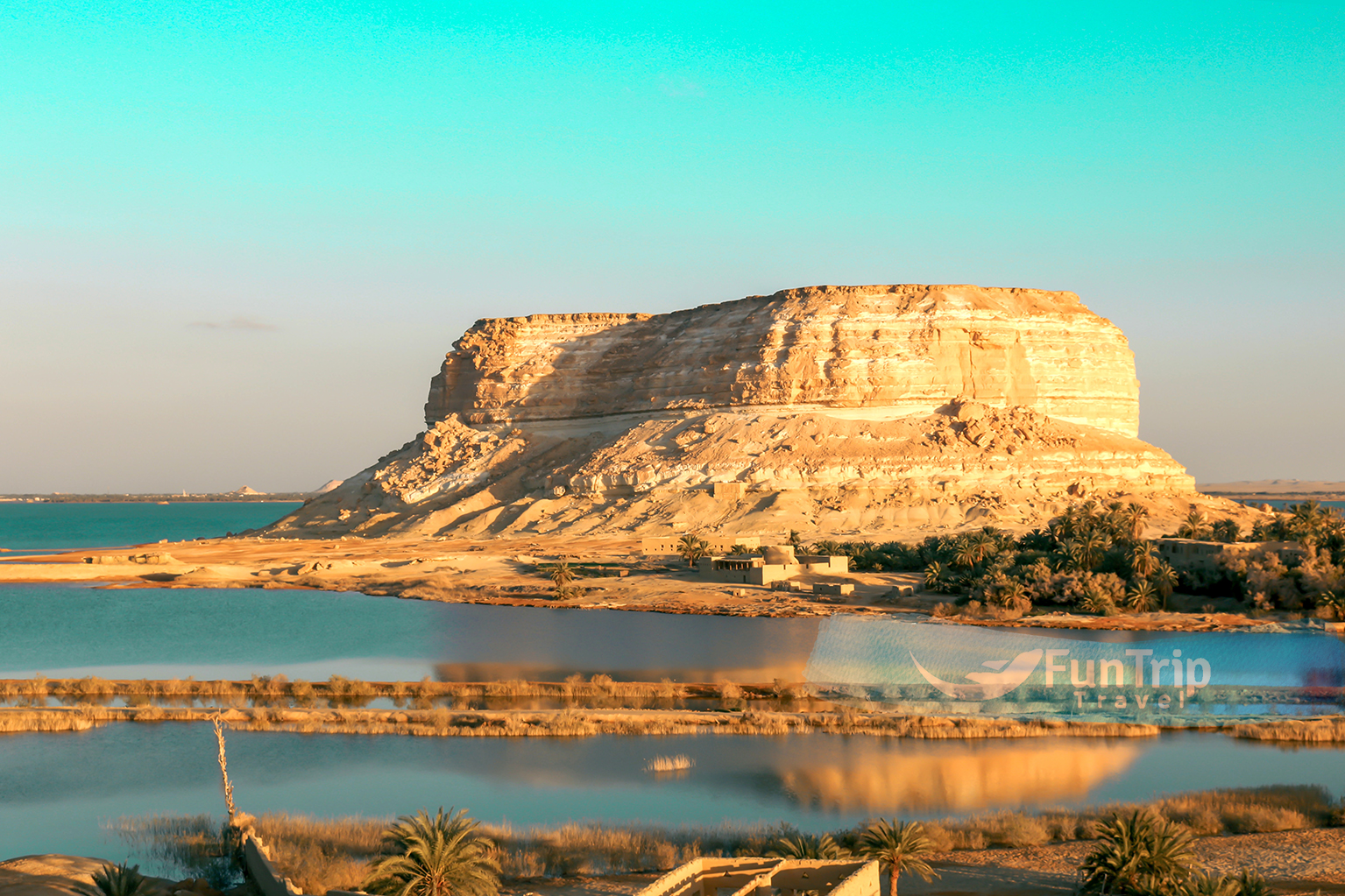Siwa oasis was populated in prehistoric times by people who came from civilizations further west, according to scientific research that began at the turn of the last century. Their lifestyle and culture had many similarities to those of Libya, North Africa, and the Nile valley.
As evidenced by numerous inscriptions discovered in temples and on tombs, the oasis has been referred to by a variety of names since antiquity, including during the Greek, Roman, and Middle Ages. From the name of the native Ti-Swa tribe, the more recent name Siwa was derived.
An important stop for trade caravans travelling from the Nile valley in the east to the Libyan Mediterranean harbours in the west across the desert was the ancient oasis of Siwa. Due to its significance, traders from southern oases and central Africa frequently visited.
Many kings sent delegates to Siwa to consult the Oracle of Amun, which contributed to the religious prosperity of the city.
The invasion of a Persian army under the command of Cambyses brought an end to the 26th Dynasty, though his 50,000-strong army would later vanish in a desert sandstorm, leaving no traces behind.
Alexander the Great’s visit in 331 BC is largely responsible for The Oracle of Amun’s fame. He chose to be buried in Siwa after consulting the oracle and claiming to be the son of Zeus Amun.
Siwa started to go into decline around the sixth century AD/ when many of the pagan temples in Siwa fell out of use thanks to the spread of Christianity. During this time, the Roman Empire fell and the region descended into anarchy, which culminated in the Arab invasion of Egypt in 640 AD.
At the height of Siwa’s glory, the change came quickly and the rewards for successful attackers could be very great. The Arabian army arrived to conquer Siwa in the eighth century. An ancient tribe of Amazigh people who had lived there under Roman rule were confronted by an Arabian army and given three options: join them, pay tribute, and live in peace, or defend their territory.
By requesting three days to make their decision, the cunning natives bought themselves some extra time. They collected all of their wealth over these three days (such as gold, jewelry, precious stones, and Pharaonic treasures). On the final day, they escaped westward carrying everything they could.
They cast spells so that their genie’s magical abilities would protect their most valuable possessions while they were away, hiding them from the Arabian soldiers and their heaviest treasures.
The Amazigh people departed in the form of a caravan in search of grass and water at a time when there was a drought affecting the nations of northwest Africa. Then, after traversing the Western Desert’s scorching sands, they arrived at Siwa, a stunning oasis with fields of apricot, olive, and palm trees that were all teeming with life. Siwa was the fulfilment of their dreams.
To increase their power and stake a claim on this rich land, the Amazigh people decided to settle here and sent word back to Algeria and Morocco in the west to invite their families to join them.
Ami Misalum, the first city, was established in the oasis’ lowlands. The Amazigh were now exposed to mosquitoes as well as attacks from hostile forces, though. They established this as their kingdom in 1103 AD after constructing a sturdy citadel on a hilltop to defend themselves and their distinctive culture.
Along with the safer location, new laws and regulations were put in place, enabling the tribal chiefs to rule Siwa as a sovereign state for hundreds of years. For instance, before the Zagala (‘strong youth’) guards would open the citadel’s doors, gardeners had to request permission from the chiefs in order to irrigate their lands throughout the night. However, the renowned Mohamed Ali contested Siwa’s independence in 1840. To demand tribute and the people of Siwa’s submission to his rule, he dispatched his Egyptian army there. To stop the Egyptian army from attacking, the Siwans dug a trench around the base of Shali; however, Ali fired rockets at the citadel, greatly damaging it.
He also gave the order to General Hussein Bek Ashamashurgi to summon 72 of the most powerful local chieftains to a meeting where they were immediately executed. As a result, the Siwans were made to submit.
The Siwans experienced many hardships as a result of the new Egyptian government system, including having to pay a one-piastre tax for each palm tree in the oasis. This persisted up until 1950, when a Bedouin businessman purchased all the dates in Siwa and settled all the state taxes owed on the trees.
The population of Siwa fluctuated from forty in the 12th century AD to about three thousand at the time of Mohammed Ali’s invasion in 1805, reflecting the city’s shifting fortunes. Siwa is still growing.

EXPLORE. CONNECT. CREATE MEMORIES
Siwa Now
After a long drive through the barren landscape of the Western Desert, you won’t believe your eyes when you arrive in Siwa for the first time. There are mineral springs, salt lakes, and endless olive and palm groves. Siwa is the stuff that desert fantasies are made of. This fertile basin, located about 50 km from the Libyan border and brimming with more than 300,000 palm trees, 70,000 olive trees, and numerous fruit orchards, is surrounded by too-saline lakes. As a result, the area has become very appealing to various types of birds, such as falcons and quails. (Bird Watching)
Siwa Set between the shady groves, slouching mud-brick hamlets are linked by winding dirt lanes where trundling donkey carts are still as much a part of the street action. Crystal-clear springs are scattered throughout the oasis, providing a welcome respite from the scorching heat. The swells of the Great Sand Sea roll to the horizon on the outskirts of the oasis, providing irresistible fodder for desert exploration. Adventurers will enjoy a safari into the Great Sand Sea or quad biking in Egypt’s Western Desert. The ruins of the 13th-century Shali fortress dominate the centre of Siwa. The ruins, made of kerchief (salt rocks from the local salt lakes and mud), are prone to further disintegration after each rainfall. You can climb to the fortress’s peak for spectacular views of the oasis and its surroundings. Siwa’s geographical isolation aided in the preservation of a distinct society from mainstream Egyptian culture. Local traditions and Siwi, the local Amazigh language mixed with slang Egyptian language, still reign supreme today. Siwa casts a spell that is challenging to resist, making the long journey out here worthwhile.

Shali Fortress
The magnificent organic shapes of the mud-brick fortress remnants constructed between the 12th and 13th centuries dominate central Siwa. The maze of huddled structures, which were originally four or five storeys high and could accommodate hundreds of people, was constructed from kerchief (chunks of salt from the lake outside of town mixed with rock and plastered in local clay). A path ascends to the top for sweeping views over the crumbling remains and past the Old Mosque with its minaret in the shape of a chimney. Few outsiders were allowed inside the fortress for centuries, and even fewer made it out alive. However, three days of rain in 1926 did more damage than any invader had been able to do, and over the following decades, residents moved to newer, more luxurious homes with electricity and running water. Currently, only a small number of the nearby buildings are occupied or being used as storage. From the main square, a path ascends to the top for stunning views of the oasis. In the old town, a number of foreigners and Egyptians are remodelling homes, some of which are available for overnight stays.
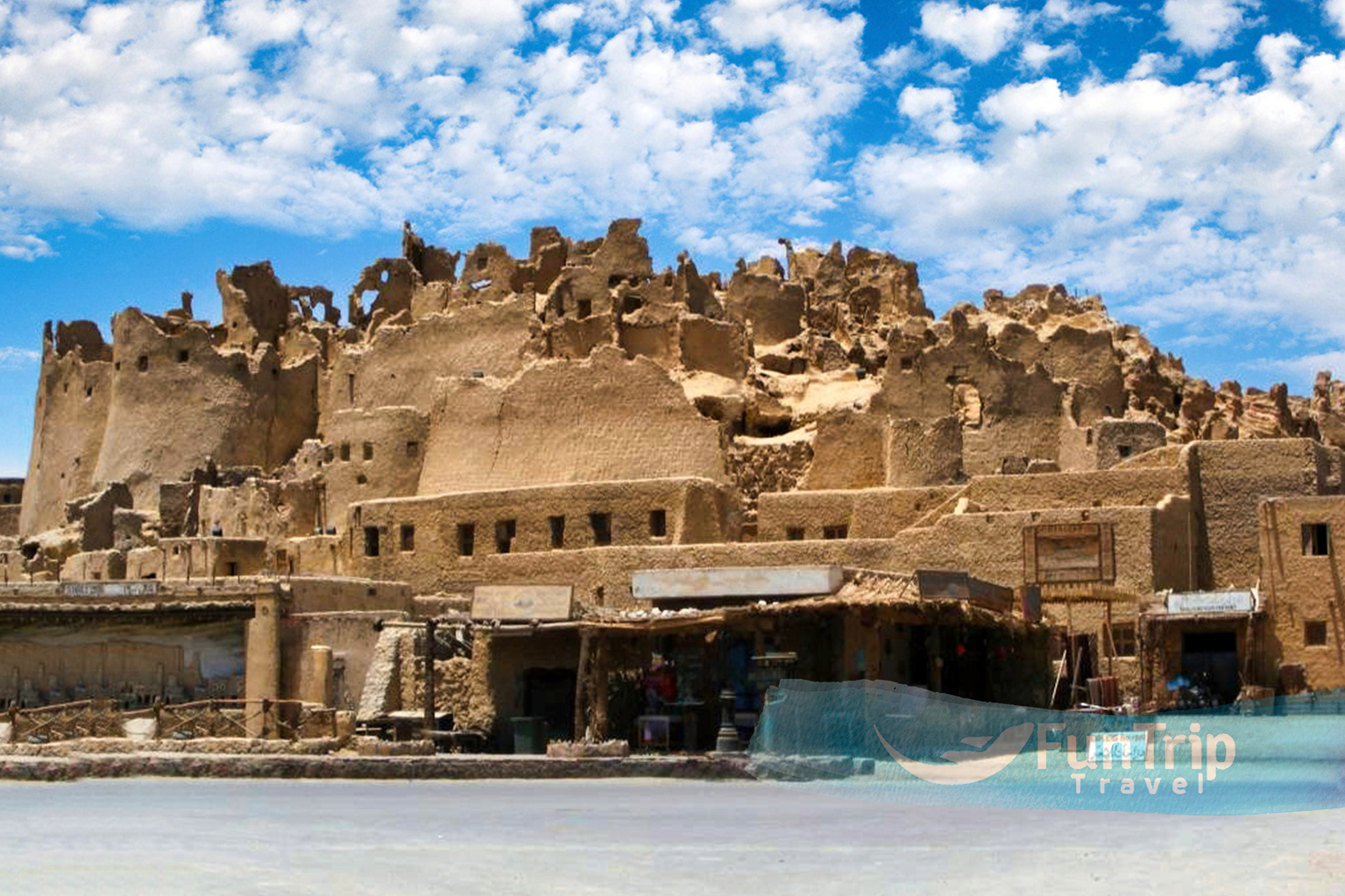
Temple Of The Oracle
In the northwest corner of the Aghurmi village ruins is the 26th dynasty Temple of the Oracle. It was dedicated to Amun (also known as Zeus or Jupiter Ammon) and served as a potent symbol of the town’s wealth when it was constructed in the 6th century BC, most likely on top of an earlier temple. It is thought that in this temple Alexander the Great was officially recognised as the son of Amun.The temple’s foundation is the subject of numerous legends. One describes two priestesses who were exiled to the desert from Thebes. Both the Temple of the Oracle in Aghurmi and the Temple of Dodona in Greece were founded by the same person. It was regarded as one of the most powerful oracles in the ancient Mediterranean, and because of its influence, some kings sought out its counsel while others sent armies to destroy it. The buttressed temple was poorly restored in the 1970s, and treasure hunters have been at work here, but it is still a stirring location rich in history. It has breathtaking views of the Siwan oasis’ palm trees and is surrounded by the Aghurmi ruin complex.

Cleopatra’s Spring
The most well-known spring in Siwa can be reached by following the path past the Temple of Umm Ubayd and the Temple of the Oracle. The Egyptian queen is rumoured to have swum in the large stone pool where the crystal-clear water gurgles up during her visit to Siwa, which is a well-liked bathing location for both locals and visitors.
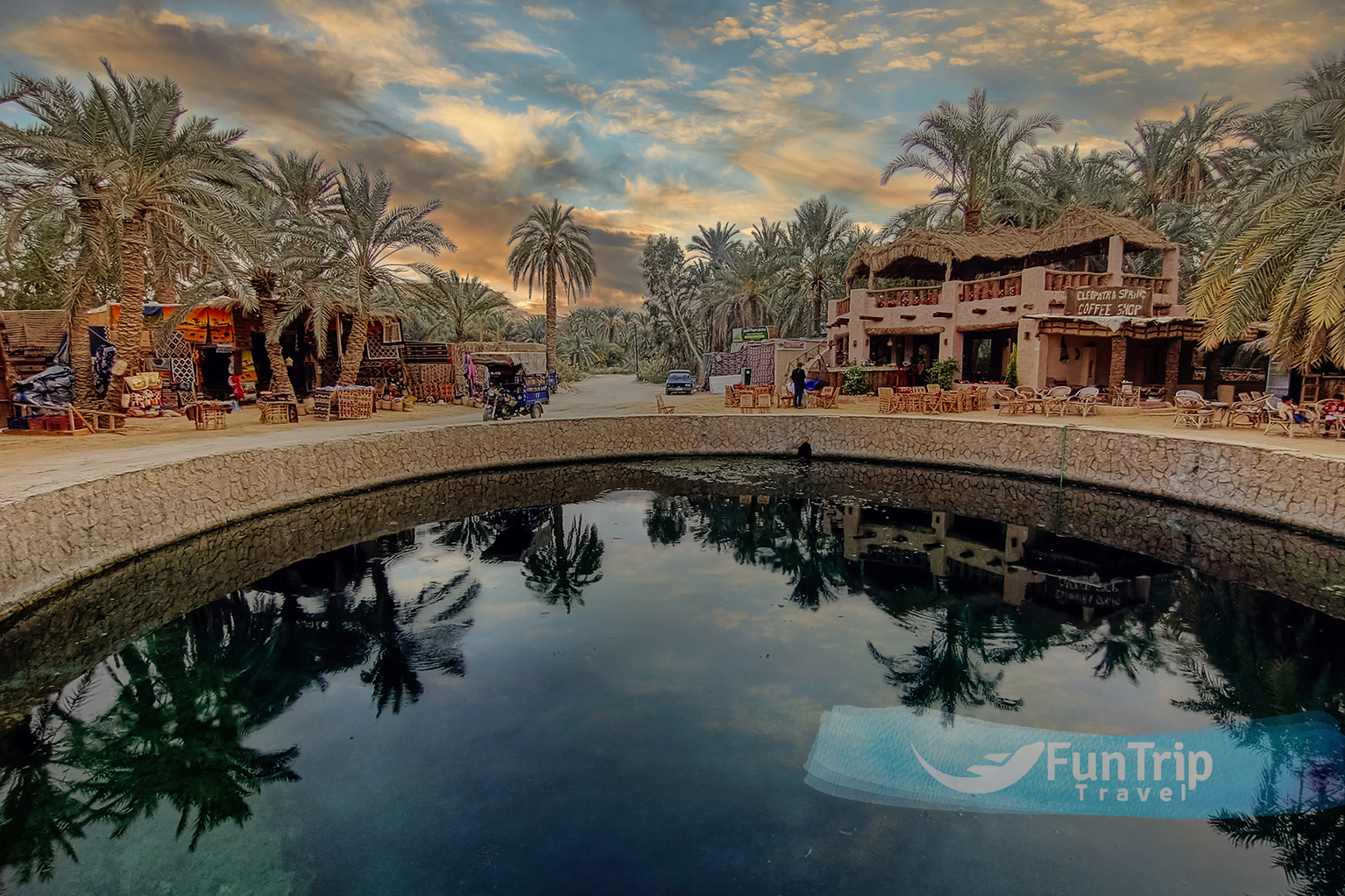
House of Siwa Museum
A fascinating collection of traditional clothing, jewellery, and crafts unique to the oasis can be found in this tiny museum. Just to look at the wedding gowns is worth the entrance fee. Northwest of the King Fuad Mosque is a block away.
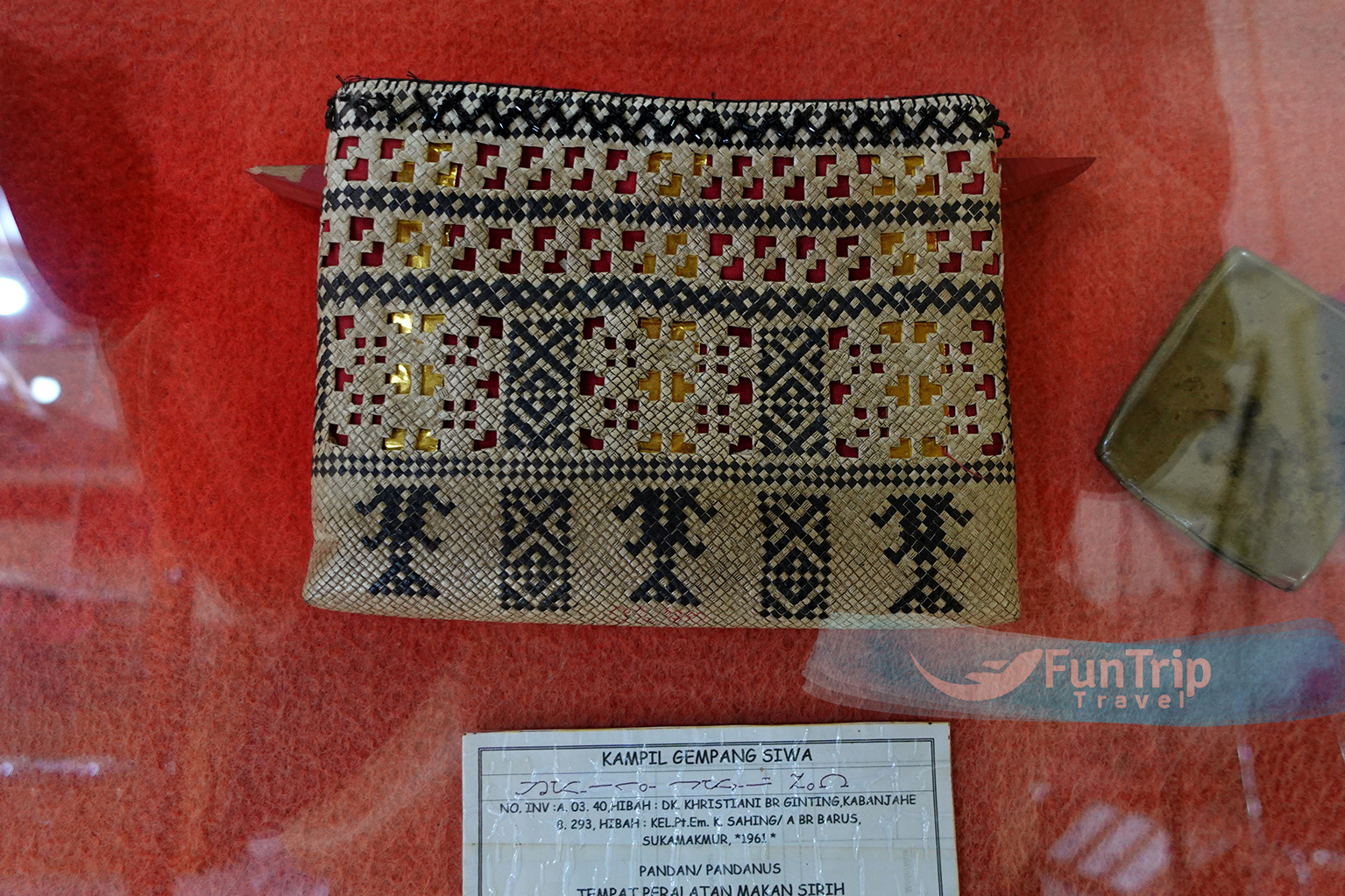
Gebel Al Mawta
There are numerous rock tombs and wall paintings scattered throughout this small hill at the northernmost point of Siwa Town. The majority of the tombs in Gebel Al Mawta, which translates to “Mountain of the Dead,” date to the 26th dynasty, the Ptolemaic era, and the Roman era. The tombs, which are only a mile from the town centre, were used as shelters by the Siwan people when the Italians bombed the oasis in World War II. The most impressive artwork can be found in the Tomb of Si Amun, where richly coloured reliefs show the deceased man—who is believed to be a wealthy Greek landowner or merchant—making sacrifices and praying to Egyptian deities. The incomplete Tomb of Mesu-Isis, which features a lovely red and blue depiction of cobras above the entrance; the Tomb of Niperpathot; and the Tomb of the Crocodile, whose badly deteriorating wall paintings include a yellow crocodile symbolizing the god Sobek.
All of these tombs are noteworthy.

The Old Mosque
with its recognisable minaret in the shape of a chimney, is located directly above the entrance to the Fortress of Shali. A path connects the central square to the mosque’s doorway, which has recently undergone restoration. The recently restored mosque is still standing today and is both the oldest structure constructed in Shali and the oldest mosque ever constructed using kerchief, a compound made of mud and salt.
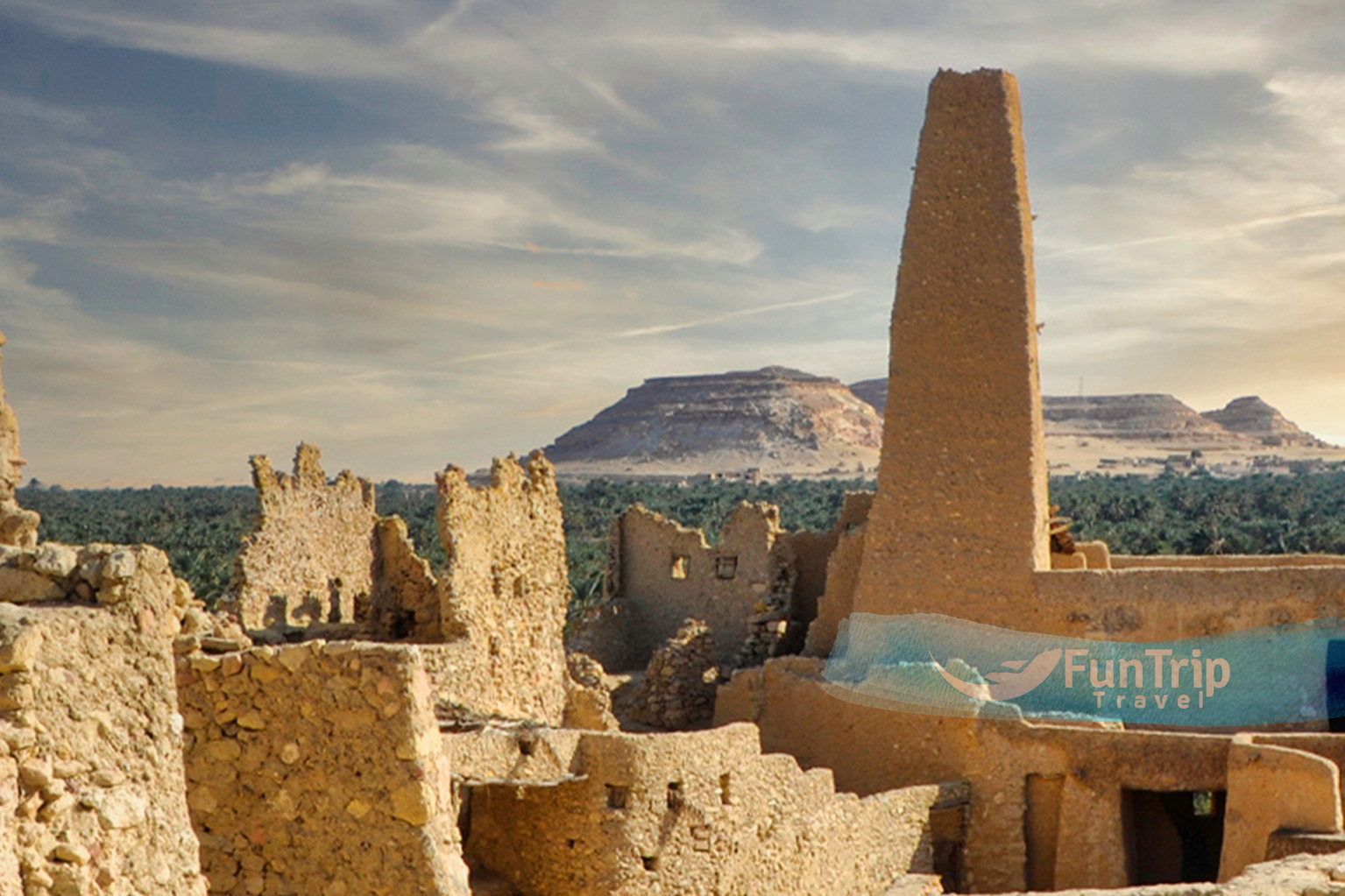
Fatnas Spring
On a small island in the salty Birket Siwa, accessible across a narrow causeway, is this reasonably remote pool. The pool, which is about 6 km from Siwa Town and surrounded by palm trees and lush vegetation, is known as “Fantasy Island” due to its dreamy setting. It’s a beautiful spot to view the setting sun.
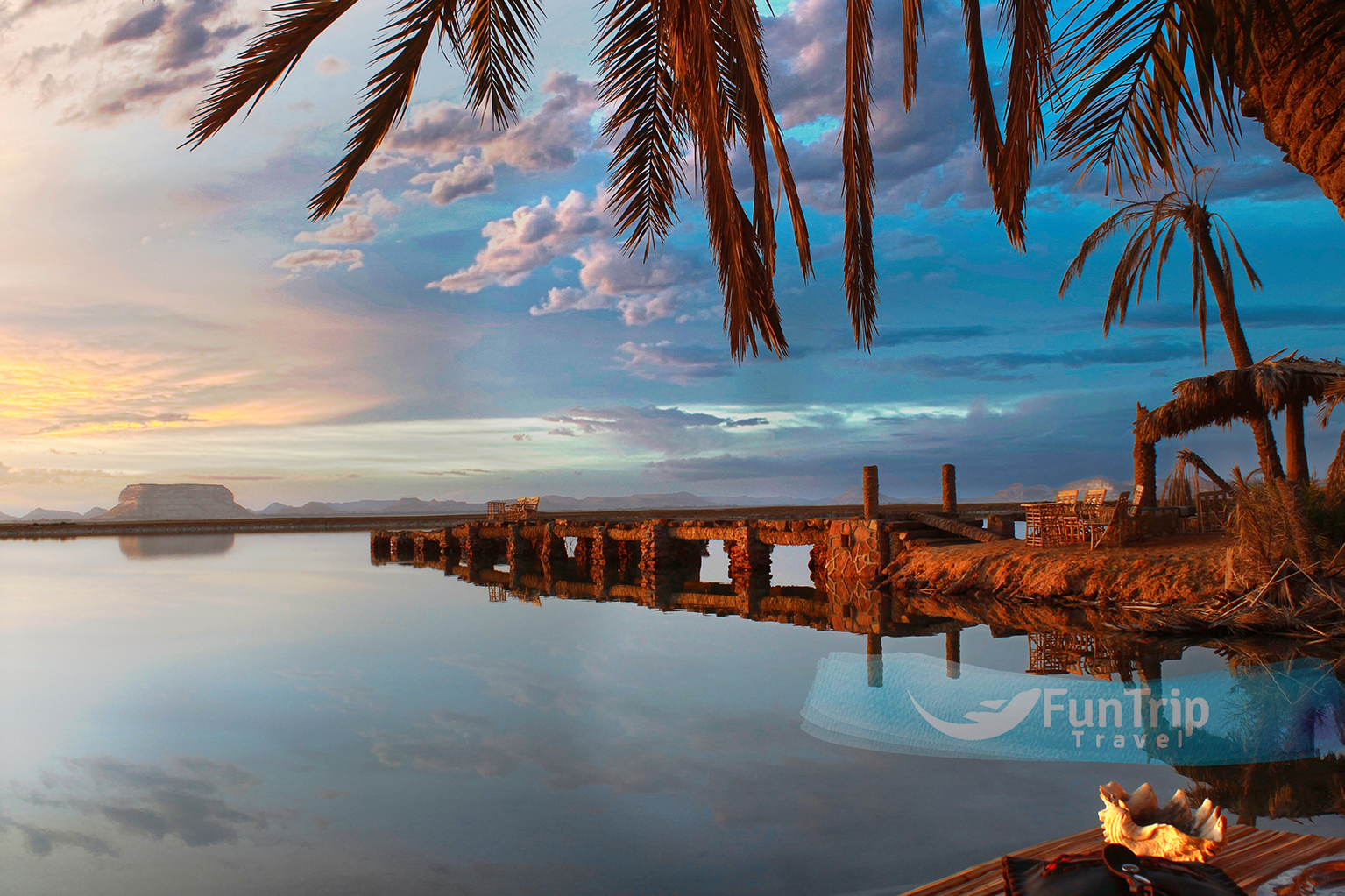
Salt Lake
In recent years, Siwa became famous for its extra-salty water after salt extraction. Since Siwa is 560km from the capital, it remains relatively unexplored. Hypersalinity distinguishes the Siwan Lakes. Due to limited yearly rainfall and excessive evaporation, Siwa’s lakes have hypersalinity, over 95% salt. Salt lakes are soothing, and Siwa’s waters are no exception. Local and international medical tourists flock to Siwa. 2017 recognized Siwa as a global medical and environmental tourist destination. Siwa is beneficial to those with skin, eye, sinus, and rheumatism.
In Siwa, there are four primary salt lakes. Zeitoun, the largest, has 5760 acres. A body of water lines the eastern edge of Siwan in Zeitoun, providing a mesmerizing view. Local enterprises use Aghormy Lake, located between Zeitoun and Maraqi lakes in the northeast, for health tourism due to its healing and revitalising properties. Maraqi Lake, in western Siwa, is one of the largest lakes at 700 acres. Fatnas Lake has the highest salt concentration among all lakes. Siwa has many smaller lakes. Siwa has “special energy” in popular culture. People believe the salt on the ground expels negative energy and rejuvenates our bodies. Swimming in Siwan Lakes is safe because the salt content keeps you floating, preventing drowning. Water is extremely salty and can hurt and irritate your eyes; therefore, avoid getting it in your eyes. These hypersalinity lakes are unsuitable for fish and marine life. People wash off salt after bathing in a salt lake. These nitrogen-rich springs are medicinal. Sand baths are another Siwa therapeutic method. Siwa is distinct, pristine, and appears the same for millennia because it is far away and not as accessible as other Egyptian tourist spots. If you want to enchant your life and body, visit Siwa and soak in its turquoise-blue salty lakes, which are so salty they feel like snow.
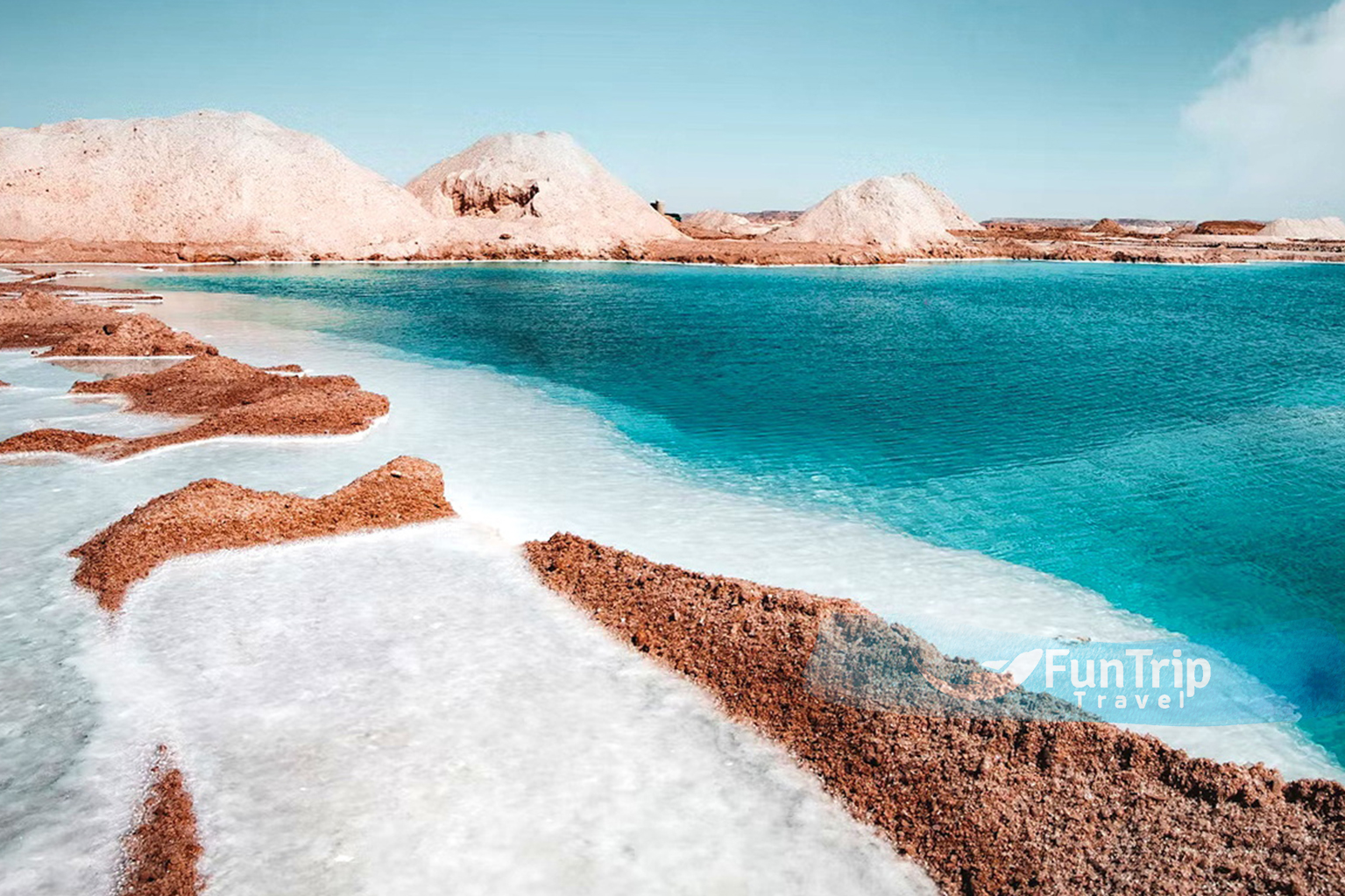
The Great Sand Sea
The enormous expanse of dune fields between the Gilf Kebir and Siwa Oasis is known as the Great Sand Sea after its discoverer, Gerhard Rohlfs (Bahr er-Raml in Arabic). The Sand Sea spans 72,000 square kilometres, or about the size of Ireland, and averages 650 kilometres from north to south and 300 kilometres from east to west. About two-thirds of this is made up of parallel seif dunes, which can be up to 150 km long and up to 100 m high. These dunes are separated from one another by flat “corridors” that are just a few kilometres wide and are aligned from northwest to southeast depending on the direction of the wind. Although these seif dunes are constantly shifting, satellite imaging has revealed that they are supported by dependable whale-backed dunes. Where seif dunes have descended escarpments in other parts of the Sand Sea, they have reformed into crescent-shaped barchans. Even though it might seem like the Sand Sea is only home to shifting sands, there is a small amount of vegetation there that can be revived by a brief rainstorm. Explorers and scientists have long been enthralled by this spectacularly alien terrain; now, tourists are venturing there to behold its wonders. The following locations can be reached on deep-desert safaris, while you can experience Bir Wahed’s enormous dunes on a quick trip from Siwa Oasis.
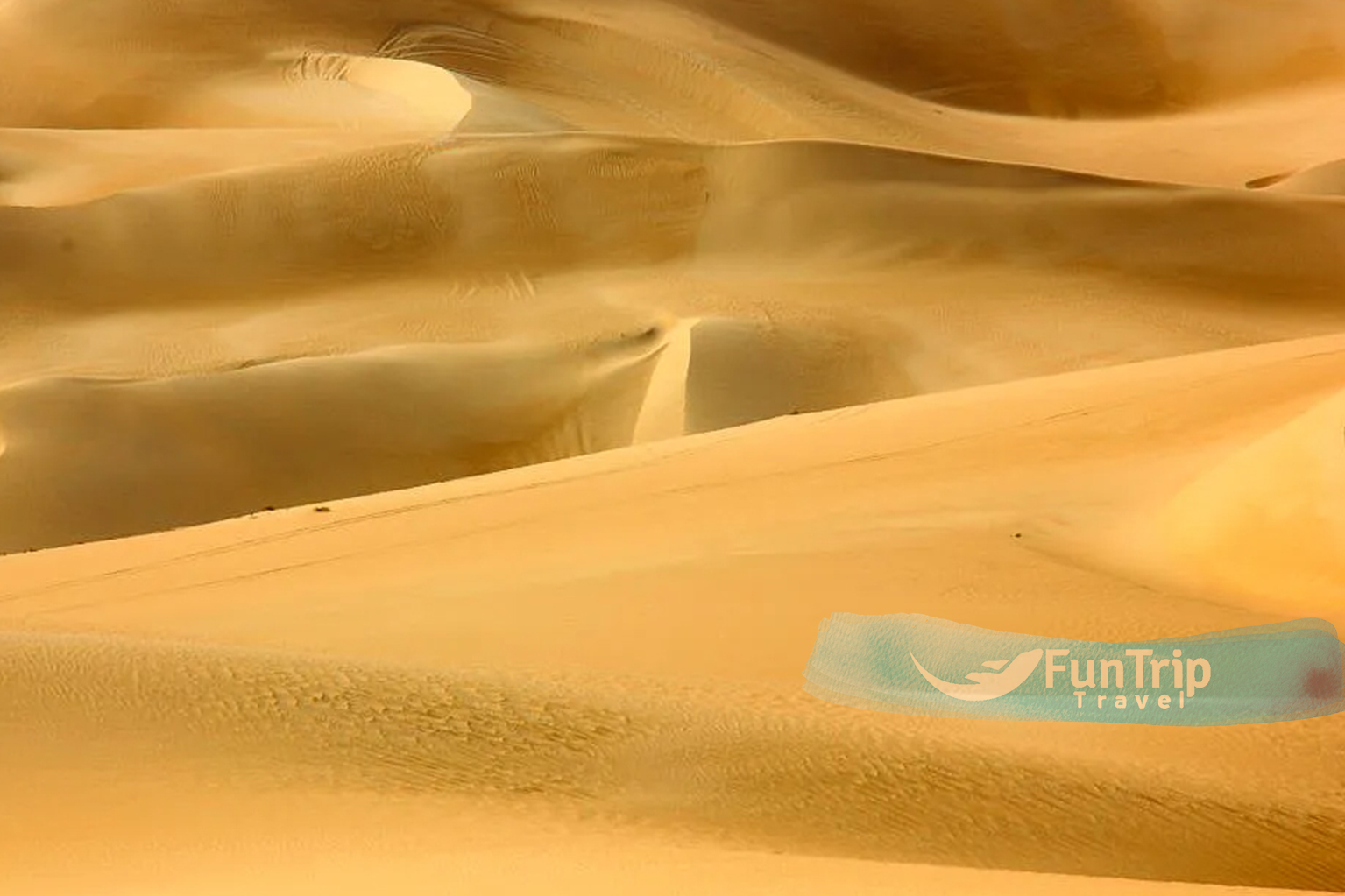
Shiatta Oasis
This breathtaking salt lake is 50 km west of Siwa Town, and it borders the Great Sand Sea with palm trees. Migratory birds, including flamingos, frequently stop here for a rest, and gazelles can also be seen. An ancient boat that once made it all the way to Siwa Town is submerged seven metres below the lake’s surface.
Bir Wahed
The 15 km away freshwater lake at Bir Wahed on the edge of the Great Sand Sea is one of the most popular Siwa excursions. Once you’ve climbed a dune, you’ll reach a hot spring the size of a big jacuzzi where sulfuric water bubbles in a pool and runs off to water a garden. A strange experience is cooling off in the lake and then taking a hot spring bath while watching the sun set over the dunes. The mosquitoes that bite at dusk and the requirement for a permit to enter Bir Wahed are the thorns in this rose.
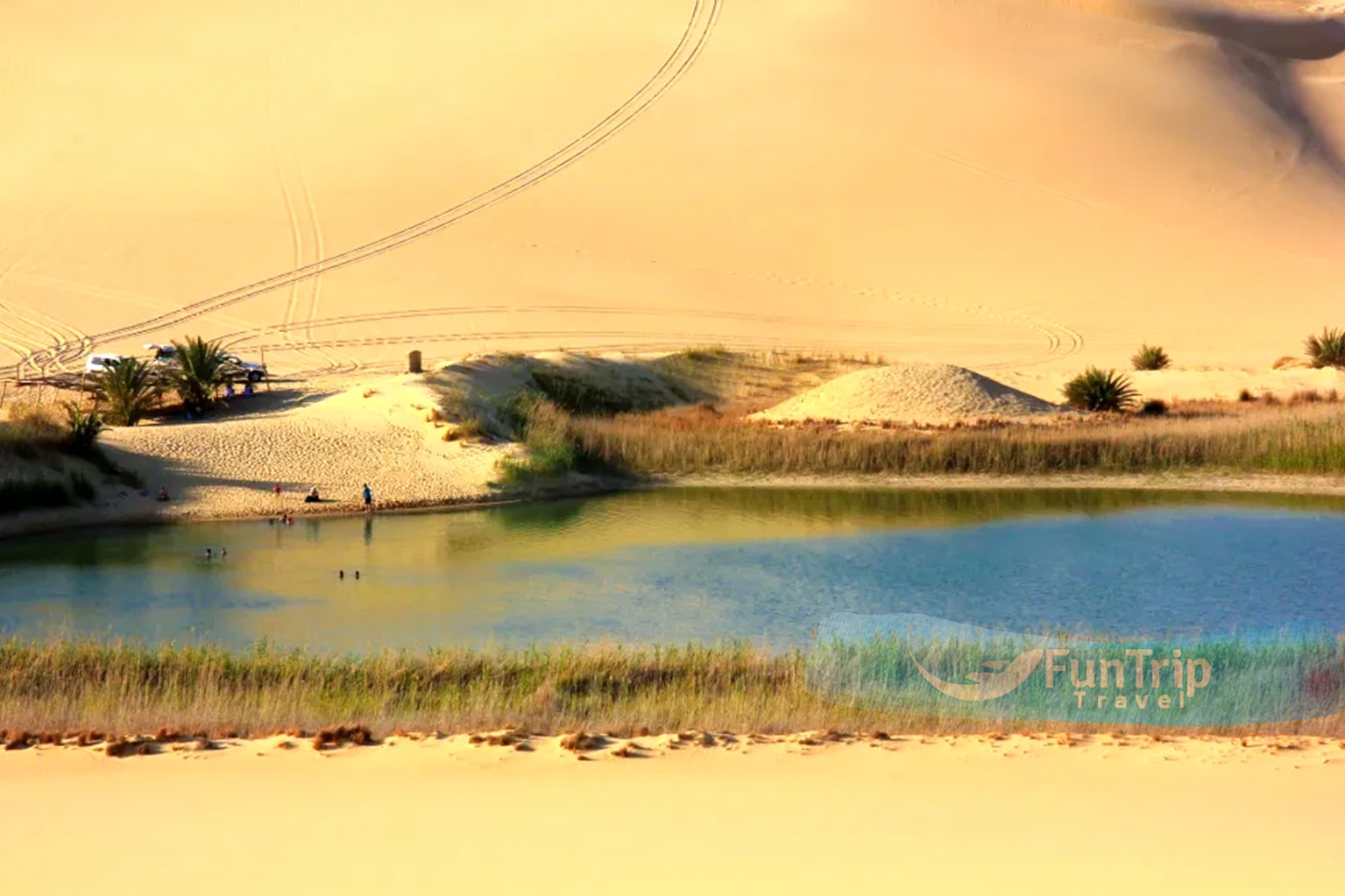
Abu Shuruof
A clean spring with healing properties, said by locals, is 27 kilometres east of Siwa Town and 7 kilometres east of Ain Qurayshat spring in the next palm thicket. The clear water here is deliciously cold, but the ambiance is somewhat marred by the nearby Hayat water-bottling plant’s sight and noise.
Az Zeitun
This abandoned mud-brick village, beaten by the sand and wind, sits alone on the sandy plain about 30 kilometres east of Siwa Town. Hundreds of Roman-era tombs have been discovered about 2 kilometres beyond Az Zeitun and are being excavated.
Ain Qurayshat
About 20 kilometres east of Siwa Town, has the oasis’s largest free-flowing spring. The causeway across salty Lake Zeitun, which has stunning views, is the best way to get to the spring.
Ain Al Arais
A cool, inviting waterhole with a grotto-like bottom just five minutes walk from the main market square, is the closest spring to central Siwa.
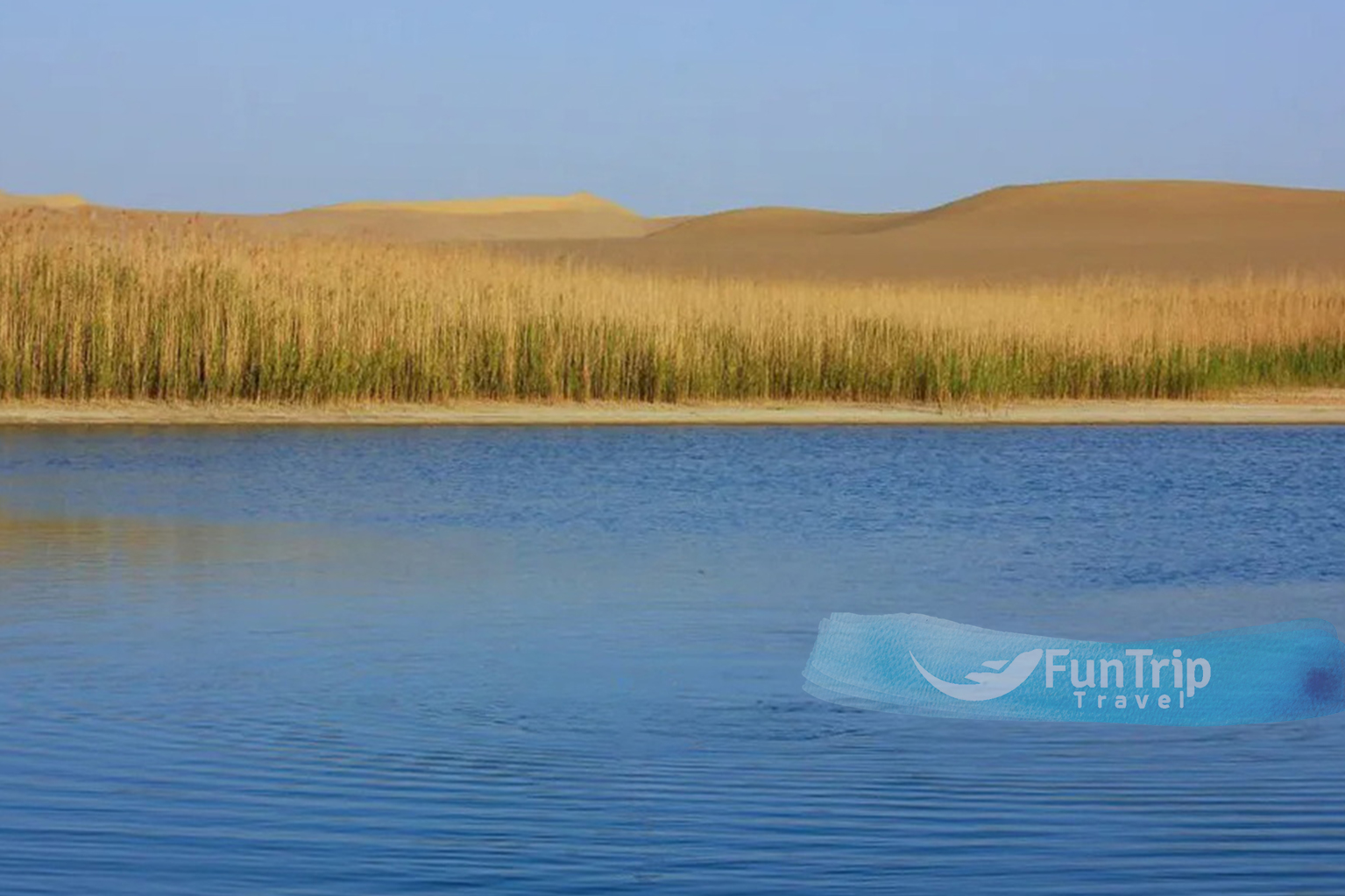
The City of the Romans
Located just north of Kharmisah, about 17 km northwest of Siwa Town, has about 100 tombs cut into the nearby hills and the ruins of a stone temple, among other places rumored to be Alexander the Great’s final resting place. Maraqi, once a poor village, is now home to chic villas owned by wealthy foreigners and Egyptians.

